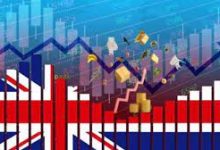Despite the strongest “hawkish” steps of the last 30 years in the Turkish economy, the risk of cooling continues to be the main risk factor in the markets.
The measures taken after the COVID-19 pandemic have caused inflation worldwide, and with the end of “dovish” policies by many central banks as the impact of the pandemic diminishes, many have switched to the “hawkish” side.
The Fed, which led the world in “hawkish” steps, increased interest rates from 25 basis points to 75 basis points and went up to a total of 450 basis points in interest rate hikes.
During the December 2022 and February meetings, the bank reduced the pace of interest rate hikes by 25 basis points each, from 75 basis points to 25 basis points, while expectations that the Fed would ultimately set its interest rate at 5.25-5.50 percent dominated pricing in the money markets during this period. However, the release of employment report data in February showing nonfarm payrolls at 517,000 in January, well above expectations, initiated a process that made pricing in the markets difficult again.
As estimates emerged in the money markets that the Fed could raise its interest rate to 6 percent, predictions that the bank would begin to cut interest rates by the end of the year lost a significant amount of strength.
The US economy is not cooling down. Macroeconomic data released in the country indicates that the economy that the Fed is trying to cool down is still hot.
Analysts said that while some of the data released indicated limited slowing economic activity, this slowing remained below market expectations, continuing to disrupt market pricing.
Non-farm employment announced on Friday increased by 311,000 in February, exceeding expectations, while unemployment rose from 3.4 percent to 3.6 percent.
Average hourly earnings, which the Fed closely monitors, also rose 0.2 percent to $33.09 during the same period. Market expectations were for average hourly earnings to increase by 0.3 percent during the same period, as in January.
While the January Consumer Price Index (CPI) in the US rose 6.4 percent and the Producer Price Index (PPI) rose 6 percent, both indices surpassed market expectations, raising questions about a downward trend in inflation.
Although factory orders fell 1.6 percent in the first month of the year, retail sales rose 3 percent in January, exceeding expectations.
Private sector employment in the US rose 242,000 in February, with market expectations for a 200,000 increase. Although the number of job openings in the US JOLTS fell to 10.842 million in January, this figure remaining above expectations was noteworthy.
The Fed’s Beige Book Report this month also noted that general economic activity had increased “slightly” at the beginning of 2023. While the report pointed to a slowdown in price increases in many regions, it also noted that inflationary pressures continued to be widespread and expected that price increases would continue to be moderate throughout the year.
The slowdown in the housing sector is not at the desired level, according to analysts. They emphasize the importance of the housing sector in the US economy and state that in previous periods, interest rate increases first affected the housing sector and then slowed down other sectors.
Analysts noted that despite the “hawkish” steps taken, the desired results have not yet been achieved in the housing sector in the country. They also stated that while increasing interest rates may not cause a slowdown in the economy, it may lead to liquidity problems in various sectors, especially in banking, which makes the Fed’s job increasingly difficult.
In January, new home sales in the US were significantly higher than expected at 670,000. The S&P Case-Shiller National Home Price Index showed a slowdown in annual growth in December, up 5.8% compared to previous months.
On the other hand, the Purchasing Managers’ Index (PMI) for the service sector in the country indicated expansion with 50.6, and consumer confidence continues to remain strong.
The University of Michigan’s consumer confidence index rose to 67 in February, and personal spending in January increased by 1.8% higher than expectations.
However, the Conference Board Consumer Confidence Index continued to decline in February. Consumers’ 12-month inflation expectations fell from 6.7% to 6.3%.














